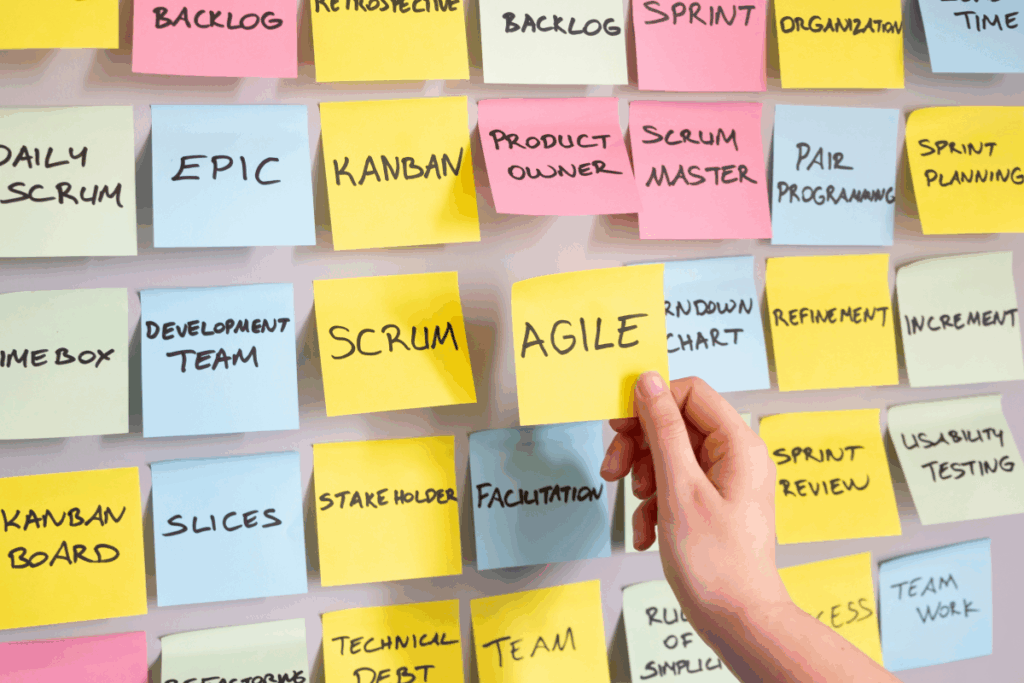In a world where project management is constantly evolving, understanding the different methodologies available is essential for any professional aspiring to excellence. You may be wondering about the most suitable approach for your projects: the Agile method, the V-Model method, or other methods such as Waterfall and Kanban?
This article aims to guide you through the nuances of these methodologies, including approaches like Extreme Programming and Agile methodology. We will examine:
- The particularities of each method: whether it's Agile, V-Model, Waterfall model, or the traditional method.
- Their advantages and limitations: to identify which approach best suits your needs.
- Practical applications in the digital field: focusing on tools like ERP solutions, and how they adapt to contemporary project requirements.
- Practical perspectives for optimal adaptation: whether your project is in its early stages or needs reorientation along the way.
Intended for experienced project managers, members of a scrum team, or simply those curious about current trends in project management, this article will offer you valuable insights. You’ll discover how these methods can evolve and adapt to the complex realities of your projects, taking into account the different components and phases, the tester’s roles, and product evolution.
So, are you ready to explore the facets of agile methods, V-Model, and beyond, to enrich your project management arsenal? Let’s embark on this adventure together!

What is the Agile method and how is it beneficial?
Project management is the art of planning, organizing, and supervising a project from start to finish to ensure its success. But what does project management actually involve in a methodology like Agile?
The Agile method, often mentioned in the world of software development and project management, is an approach that favors flexibility, adaptability, and collaboration. Unlike traditional methods, agility focuses on:
- Responsiveness to changes: instead of following a rigid plan, agile teams quickly adapt to changes in the environment or project requirements.
- Close collaboration between the team and the client: it ensures a better understanding of needs and greater client satisfaction.
- Frequent delivery of small functional segments of the project: this allows for continuous feedback collection and product improvement along the way.
Agile Scrum Cycle: how is it applied in digital service companies?
Scrum, one of the most widespread agile methodologies, is particularly suited to digital service companies. Here’s how it is generally applied:
- Sprints of defined duration: work periods (typically two weeks to a month) during which specific features are developed and tested.
- Clearly defined roles: the Scrum Master, development team, and Product Owner work together to ensure project progress.
- Daily meetings: coordination points to discuss progress and encountered obstacles.
Agile Method vs Classic Method: what are the distinctive advantages for modern businesses?
The Agile method differs from the classic method, often called “waterfall”, by several key advantages:
- Increased flexibility: the ability to quickly adapt to changes is a major asset in a rapidly evolving business environment.
- Better client collaboration: client involvement throughout the project ensures a better fit of the final product with their expectations.
- Improved risk management: with frequent deliveries, problems are identified and resolved earlier.
Exploring the V-Model: definition and practical applications
The V-Model is a project management methodology characterized by a sequential and linear approach. Each project stage is followed by a corresponding testing phase. This includes:
- Sequential design and development: each phase must be completed before moving to the next.
- Thorough testing at each stage: this ensures that errors are identified and corrected early in the project lifecycle.
- Visibility and transparency: each team member has a clear view of the project's progress.
What is the nature of the V-Model in technological projects?
In technological projects, the V-Model is often chosen for:
- Its clear structure: ideal for projects where requirements are well-defined and unlikely to change.
- Its rigor in testing: each development phase is accompanied by a corresponding testing phase, reducing the risk of errors in the final product.
Advantages and disadvantages of the V-Model: How do they impact project management?
The advantages of the V-Model include:
- Clarity and predictability: well-defined steps facilitate planning and management.
- Integrated quality assurance: testing at each stage ensures compliance with initial requirements.
However, its disadvantages should be considered:
- Lack of flexibility: less suitable for projects where requirements are likely to change along the way.
- Limited reactivity: late changes in the project can be costly and difficult to integrate.
Comparative analysis: Agile versus V-Model
In the world of project management, two methodologies stand out particularly: the Agile method and the V-Model. Each has its specificities, adapted to different types of projects and environments. But how do you know which one to choose for your project? Understanding their fundamental differences is key.
Difference between the V-Model and the Scrum Method: What are the selection criteria?
The V-Model and the Scrum method (a popular form of Agile) mainly differ in their approach to project planning and execution.
V-cycle :
- Detailed planning: each step is defined in advance.
- Sequential approach: phases only start once the previous one is completed.
- Ideal for: projects where requirements are clear and unlikely to change.
Scrum Method:
- Flexibility and adaptability: possibility to modify the project as it progresses.
- Iterative approach: work is carried out in sprints, allowing for regular adjustments.
- Ideal for: projects in dynamic environments with evolving requirements.
The choice between these two depends on the nature of your project and the flexibility required in terms of change management. So agile vs scrum, which do you choose?
V-Model vs Agile: What are the specificities of each method for digital service companies?
In the context of digital service companies, where responsiveness and rapid adaptation to client needs are essential, choosing the right project methodology is crucial.
V-cycle :
- Rigorous control: suitable for projects with well-defined requirements.
- Thorough testing: each development phase is followed by a corresponding testing phase.
- Security: better for projects where risk must be minimized.
Agile:
- Speed and flexibility: allows for quick adaptation to changing client demands.
- Continuous delivery: functional versions are regularly delivered.
- Client collaboration: strongly involves the client in the development process.
Strategic choice: When to favor one method over the other?
The decision to choose between the V-Model and Agile depends on several factors related to the project and work environment.
Why choose the V-Model method for your project?
- Well-defined projects: ideal when project requirements are clear and stable.
- Regulated sectors: preferred in areas where compliance with standards and procedures is essential.
- Minimal risk: allows for stricter risk control due to its sequential structure.
Why favor the Agile method in a dynamic environment?
- Fluctuating requirements: Agile adapts better to constant changes in project requirements.
- Continuous innovation: promotes innovation and experimentation through its rapid iterations.
- Collaboration and communication: strengthens collaboration between the team and stakeholders, including clients.
Each of these methods has its own set of strengths and weaknesses. The choice will therefore strongly depend on your project context, the industry in which you operate, and the specific objectives you seek to achieve.
Impact of integrating management methods in ERPs like Furious Squad
The integration of project management methods in ERP systems like Furious Squad is revolutionizing the way companies approach the management of their projects and teams. In this context, understanding how Furious Squad leverages Agile and V-Model methods is essential to grasp the impact of these integrations.
How does Furious use Agile and V-Model methods to optimize project management?
Furious Squad, as an innovative ERP solution, has skillfully incorporated the principles of Agile and V-Model methods to offer an enhanced project management experience:
- Agility and responsiveness: by integrating agile practices, Furious Squad allows teams to quickly adapt to changes, thus promoting better project management in a dynamic environment.
- Precise and structured planning: the use of the V-Model in Furious Squad ensures a more structured approach, with detailed planning and clear validation stages, ideal for projects requiring increased precision.
The efficiency of an ERP in implementing project management methods: The case of Furious
Furious Squad perfectly illustrates how an ERP can improve project management efficiency:
- AI-assisted planning: with advanced features such as artificial intelligence-assisted planning, Furious offers a comprehensive view and optimization of resources and timelines.
- Intuitive dashboards: customizable dashboards allow real-time monitoring of project performance, thus improving decision-making and risk management.
- Enhanced collaboration and communication: thanks to its conversational interface, Furious Squad facilitates collaboration and information sharing among team members, strengthening team efficiency and cohesion.
In conclusion, Furious, by integrating these project management methodologies, offers a comprehensive and flexible solution, adapted to modern project management challenges, while maximizing team efficiency and productivity.
You may be asking yourself these questions?
01 is My Project Profitable?
Do you take into account the time spent on pre-sales? Project management? Purchases? With Furious, get a complete real-time analysis of your projects’ profitability, allowing you to adjust your strategies before incurring losses.
02 Quotes
Generate, modify, and send your quotes in just a few clicks from your rate tables.
03 Your gross margin at any time
Each sale must contribute to your company’s profitability. From quote generation to project completion, Furious provides you with the real-time gross margin of the project.
04 Control your pre-sales
No more pre-sales efforts that harm the profitability of a project before it even starts. Understand at a glance the impact of your pre-sales on your current prospects and quickly correct course.
05 Sales dashboard
Customize the indicators you follow at any time. Stay in control of your business with real-time reporting.
06 Automation
From automated actions to those scheduled for the future, ensure an ideal process for each of your prospects and maximize your chances of converting them into clients.

